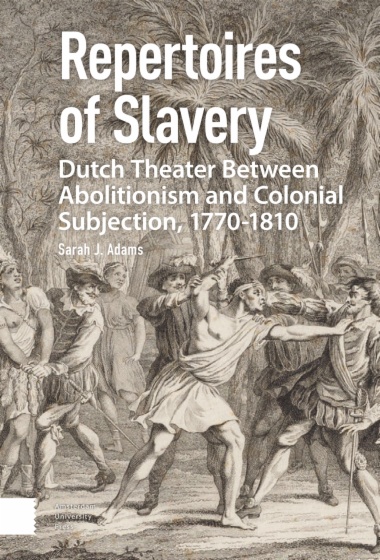Through the lens of a hitherto unstudied repertoire of Dutch abolitionist theatre productions, Repertoires of Slavery prises open the conflicting ideological functions of antislavery discourse within and outside the walls of the theatre and examines the ways in which abolitionist protesters wielded the strife-ridden question of slavery to negotiate the meanings of human rights, subjecthood, and subjection. The book explores how dramatic visions of antislavery provided a site for (re)mediating a white metropolitan—and at times a specifically Dutch—identity. It offers insight into the late-eighteenth- and early-nineteenth-century theatrical modes, tropes, and scenarios of racialised subjection and considers them as materials of the “Dutch cultural archive,” or the Dutch “reservoir” of sentiments, knowledge, fantasies, and beliefs about race and slavery that have shaped the dominant sense of the Dutch self up to the present day.
- Cover
- Table of Contents
- Acknowledgements
- Introduction
- 1. Dutch Politics, the Slavery-Based Economy, and Theatrical Culture in 1800
- A Golden Age?
- Economic Downturns and Political Uprisings
- Dutch Abolitionism and Resistance in the Colonies
- The Politics and Aesthetics of Dutch Theater
- 2. Suffering Victims: Slavery, Sympathy, and White Self-Glorification
- Selico and the Pattern of the Disrupted West African Family
- Plantation Testimonies and Sympathy Rewarded in De negers
- Kraspoekol, the Colonial Oikos, and the Bildung of the White Hero
- Antislavery as a “Window of Opportunity”
- 3. Contented Fools: Ridiculing and Re-Commercializing Slavery
- Blacking-Up around 1800
- “A Black needs little to enjoy his life”
- Subversion and Spectacle in Pantalon, Oost-Indisch planter
- Zabi, or Early Blackface Burlesque in Paulus en Virginia
- The Repertoire of Slavery, Minstrelsy, and Black Pete
- 4. Black Rebels: Slavery, Human Rights, and the Legitimacy of Resistance
- Monzongo and the Justified Revolt against Spanish Tyranny
- Imagining the Haitian Revolution and the Black Spartacus in De blanke en de zwarte
- The Batavian Temple of Liberty
- A Pedestal for Raynal?
- 5. Conclusions
- Bibliography
- Appendix
- 1 Antislavery Plays Published in the Netherlands, 1770–1810
- 2 Performances of the Dutch “Repertoire of Slavery”
- Index
- List of Figures
- Figure 1 Colored engraving for Jean-Pierre C. de Florian, “Selico, eene Afrikaansche geschiedenis,” in Nieuwe vertellingen van den heer M. Florian, trans. Daniël Vrijdag (The Hague: J.C. Leeuwenstijn, 1801). We see the three brothers taking care of their
- Figure 2 Engraving by Quirinus van Amelsfoort for Adriaan van der Willigen’s Selico (Haarlem: Jan van Walré, 1794). Selico and Berissa are freed from the stake, and Faruhlo is depicted kneeling in front of Trura Audati, who sits on his royal throne. The
- Figure 3 Costume design for an “African Sovereign” (“Afrikaansch Vorst”) by Leerzaam Vermaak (ca. 1785–1817).
- Figure 4 Engraving for August von Kotzebue, Die Negersklaven: Ein historisch-dramatisches Gemählde in drey Akten (Leipzig: Kummer, 1796). The engraving depicts the kneeling mother, pointing at her chest to show how she pierced her baby’s heart with a nai
- Figure 5 Engraving for Dirk van Hogendorp’s Kraspoekol, of de slaaverny (Delft: M. Roelofswaert, 1800). Tjampakka in the middle, with half of the plate in her hands as proof that the plate was already broken.
- Figure 6 Pencil drawing by Jan Brandes (1782–1783). The enslaved girl Roosje and Brandes’s son, Jantje, in an office in Batavia.
- Figure 7 Watercolor by Jan Brandes, depicting free and enslaved people of Ceylon and the traditional condé hairstyle, which also appears in van Hogendorp’s index of characters (1785–1786).
- Figure 8 Color drawing by Jan Gerard van der Wall, depicting the costumes for the carnival of De Democriet of March 17, 1801. “Van Belle,” dressed as a Black servant, is depicted top left.
- Figure 9 “Diorama of a Slave Dance” by Gerrit Schouten, made from wood and plant material (ca. 1830).
- Figure 10 Watercolor drawing by François Joseph Pfeiffer, costume designs for two Afro-diasporic captives (1797 at the earliest). Characters with darkened skin, short curly hair, and conventional costumes and props.
- Figure 11 Selection of commedia dell’arte masks for Harlequin (20th century copied from 18th-century models).
- Figure 12 Colored catchpenny print “De zegepraal,” in a series of four prints about Paulus en Virginia, published with Établ. Glénisson and Van Genechten (1833–1856). Domingo, Zabi, and others carry Paulus and Virginia on a stretcher made from branches a
- Figure 13 Engraving by Daniël Veelaard after Jacob Smies’s drawing of the interior of theater-café De Ooievaar in the Sint-Antoniesbreestraat (1808). Also printed in Fokke Simonsz’s Amsterdamsche Burgers-Winter avond-Uitspanningen (1808).
- Figure 14 Announcement for the “Lantum Ethiopian Serenaders” in the Nieuwe Rotterdamsche courant (12-08-1847).
- Figure 15 Engraving by Reinier Vinkeles, frontispiece for Nicolaas Simon van Winter’s Monzongo, of de koningklyke slaaf (Amsterdam: Pieter Meijer, 1774). Monzongo, in the middle, attacking Alvarado. Melinde and Semire in the back.
- Figure 16 Watercolor by François Joseph Pfeiffer, “Costume design for an Indian” (“Kostuumontwerp voor een indiaan”) (ca. 1800). This costume may well have served to represent Monzongo in the Amsterdam Theater. In a later cartoon of van Winter’s protagon
- Figure 17 Colored drawing, costume design for Melinde made for a production of Monzongo at Leerzaam Vermaak (ca. 1785).
- Figure 18 Cartoon depicting Monzongo as a figure of resistance, in response to the currency act of 1874. Published in De Nederlandsche Spectator, no. 10 (1874).
- Figure 19 Theater bill for the performance of De verlossing der slaaven door de Franschen on April 25, 1795.
- Figure 20 �“Tempel van de Bataafse Vrijheid” engraving by Jan Gerritsz Visser (1795).

